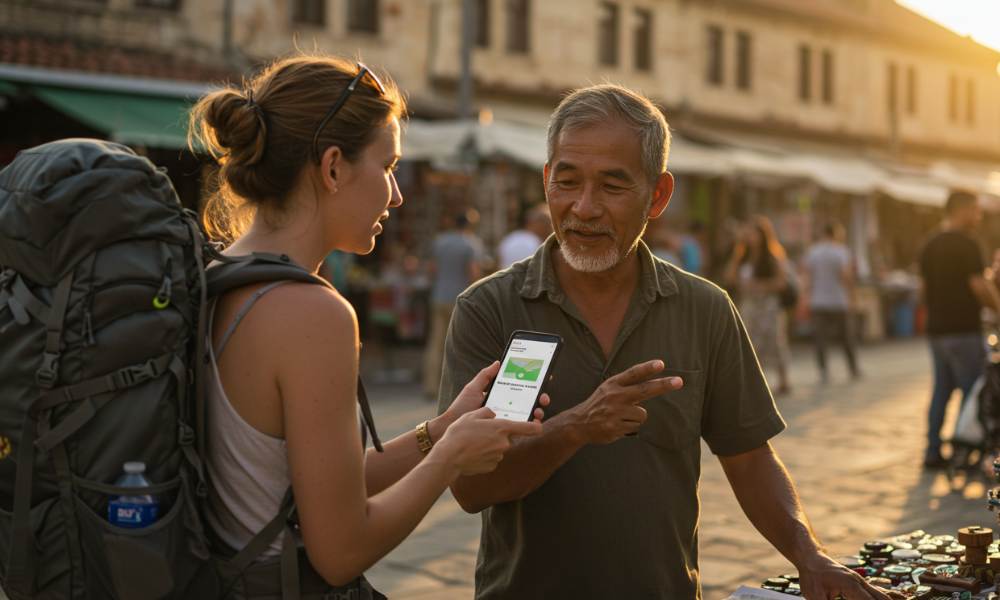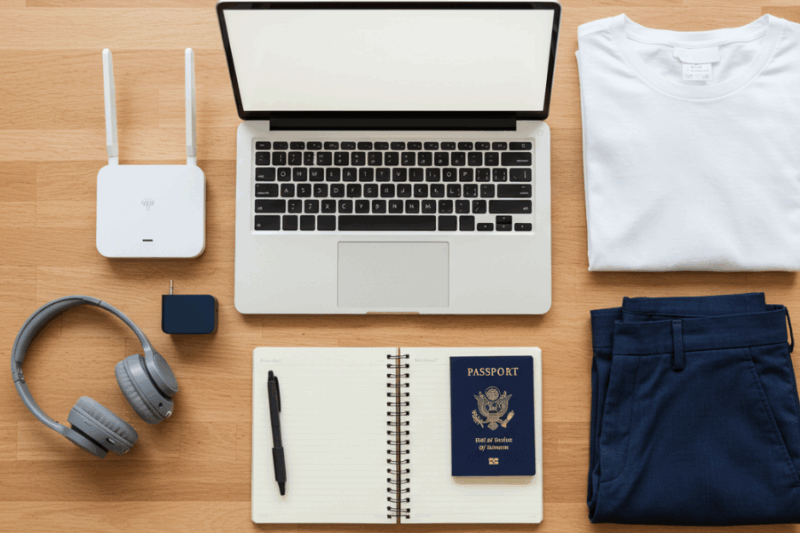Traveling to a country where you don’t speak the local language can feel daunting, but it’s entirely possible to navigate and enjoy your journey with the right strategies. For minimalist travelers, overcoming language barriers aligns with the ethos of simplicity—using minimal tools and a resourceful mindset to focus on experiences rather than obstacles. Whether you’re exploring markets in Morocco or temples in Japan, these practical tips will help you travel confidently without fluency, keeping your packing light and your adventures stress-free.

Why Language Barriers Don’t Have to Stop You
Language differences are a natural part of travel, especially in diverse regions like Asia, where dialects shift across borders. With technology, body language, and preparation, you can communicate effectively without speaking the local tongue. On my trip to Hanoi, I managed vibrant street markets with zero Vietnamese, relying on apps and gestures. These methods save time, reduce mental clutter, and let you immerse in the culture, all while carrying just a backpack.
1. Learn Key Phrases Before You Go
Memorizing 5–10 basic phrases can go a long way, requiring no extra effort beyond a few minutes of practice. In Thailand, knowing “sawasdee” (hello), “khob khun” (thank you), and “tao rai” (how much?) helped me connect with vendors in Chiang Mai. Focus on greetings, numbers, and essentials like “where is…?” or “bathroom.” Use apps like Duolingo (free) or phrasebooks (e.g., Lonely Planet, $5–10) to practice offline. Write phrases in a small notebook ($3) for quick reference. How to Do It: Spend 10 minutes daily for a week before your trip. Practice pronunciation via YouTube or Google Translate’s audio feature.
Why It Works: Shows respect and builds rapport, easing interactions.
Time: 10 minutes/day pre-trip.
2. Use Translation Apps Offline
Smartphone apps bridge language gaps instantly, perfect for minimalist travelers who rely on a single device. Google Translate (free) offers offline translation for over 100 languages, including text, voice, and camera modes (e.g., translating menus by scanning). In Japan, I used it to read Kyoto street signs and order ramen ($5) without speaking Japanese. Download language packs before you go to avoid data costs. iTranslate and Microsoft Translator (free) are solid alternatives. How to Do It: Download Google Translate and relevant language packs (e.g., Thai, Vietnamese). Practice using camera mode for signs or menus.
Why It Works: Provides real-time communication without Wi-Fi, keeping your kit light (just your phone).
Cost: Free (phone already packed).
3. Rely on Non-Verbal Communication
Gestures, facial expressions, and body language are universal tools for communication. In Morocco’s Fez medina, I used hand signals to bargain for a scarf ($3) and pointed at ingredients to order tagine ($4). Smile, nod, and mimic actions (e.g., eating motion for “food”) to convey needs. Be mindful of cultural differences—e.g., pointing with your foot in Thailand is rude. Observe locals to learn acceptable gestures. How to Do It: Practice common gestures (pointing, waving, thumbs-up). Watch locals for cues and avoid offensive motions (research pre-trip).
Why It Works: Bypasses language entirely, fostering connection with zero gear.
Time: 5 minutes observing/day.
4. Carry Visual Aids
Simple visual tools can clarify your needs without words. In Cambodia, I carried a small notebook ($3) with sketches of a bus, hotel, or fork/spoon to ask for directions or food. Pointing at photos on your phone (e.g., a dish or landmark) also works—save images offline in Google Photos (free). For complex needs, like medical issues, use pre-downloaded pictogram apps like Point It ($2).
How to Do It: Pack a pocket-sized notebook and pen ($3 total). Save photos of key items (train, toilet) on your phone. Download Point It for emergencies.
Why It Works: Visuals are universally understood, minimizing confusion.
Cost: $3–5 (notebook, app).
5. Seek English-Speaking Locals
In tourist-friendly areas, younger locals, students, or hospitality workers often speak basic English. In Siem Reap, I asked a hostel staffer to explain tuk-tuk fares ($2–3), saving me from overpaying. Hostels, cafes, and tour agencies are great places to find English speakers. Use X or TripAdvisor to identify tourist hubs (e.g., Pub Street in Siem Reap). Be patient and speak slowly, avoiding slang. How to Do It: Stay in hostels ($5–15/night) or visit cafes with Wi-Fi. Ask, “Do you speak English?” with a smile. Search X for local recommendations.
Why It Works: Leverages existing resources (people) without extra tools.
Cost: Free (hostel already budgeted).
6. Simplify Your Requests
Keep communication clear by using simple words and short sentences. In Vietnam, instead of asking, “Can you tell me where the nearest museum is?” I said, “Museum? Where?” while pointing. This worked at Hanoi’s Old Quarter, guiding me to the Women’s Museum ($1 entry). Combine with gestures or apps for clarity. Avoid idioms or complex questions that confuse non-native speakers. How to Do It: Practice basic sentences (e.g., “Food?,” “Bus station?”). Pair with pointing or showing photos on your phone.
Why It Works: Reduces misunderstandings, keeping interactions smooth.
Time: 2–3 minutes/practice.
7. Join Guided Tours or Group Activities
Guided tours or group activities often include English-speaking guides, eliminating language barriers. In Kuala Lumpur, I joined a free walking tour (tip $5) at Merdeka Square, where the guide explained history in English, saving me from navigating signs. Hostels offer group outings (e.g., cooking classes, $10–20) with bilingual leaders. Check Hostelworld or GetYourGuide for options. How to Do It: Book tours via hostels or apps like GetYourGuide. Look for “English-speaking” in descriptions. Join hostel-organized events.
Why It Works: Guides handle communication, letting you focus on enjoyment.
Cost: $0–20/activity.
Minimalist Travel Tips
- Pack Light: Carry only a phone (with apps), notebook ($3), and pen ($1) for communication—fits in a 20L backpack (e.g., Osprey Daylite, $50).
- Budget Wisely: Street food ($1–3/meal) and hostels ($5–15/night) keep costs low ($15–30/day). Translation apps and gestures are free.
- Stay Prepared: Download offline maps (Maps.me, free) and language packs before travel to avoid data costs ($5–10/day).
- Cultural Respect: Learn local etiquette (e.g., bowing in Japan) to enhance interactions. A scarf ($5) ensures modesty in temples.
- Practice Patience: Misunderstandings happen; smile and try again. Locals appreciate effort, like my attempt at “arigatou” in Tokyo.
- Backup Plan: Save embassy contacts and local emergency numbers (free) in case of serious communication issues.
Why These Strategies Work
Traveling without speaking the local language is manageable with a minimalist approach—using free apps, simple gestures, and basic preparation. These methods kept my Thailand trip seamless, saving $10–20/day by avoiding tourist traps through local interactions. They reduce mental clutter, letting you focus on cultural immersion, from bargaining in Chiang Mai to ordering pho in Hanoi. With just a phone and a notebook, you’re equipped to navigate anywhere.



